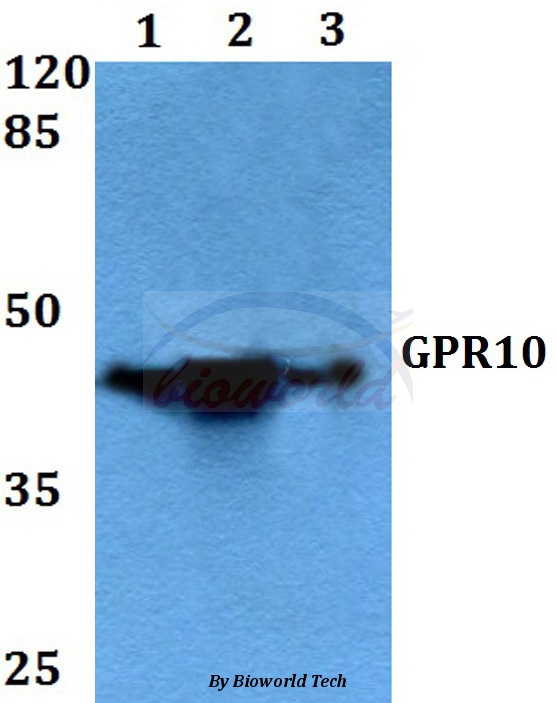Product Name :
GPR10 (Q223) polyclonal antibody Background :
G protein-coupled receptors (GPRs or GPCRs), also known as seven transmembrane receptors, heptahelical receptors or 7TM receptors, are members of the largest protein family and play a role in many different stimulus-response pathways. G protein-coupled receptors mediate extracellular signals into intracellular signals (G protein activation). They respond to a great variety of signaling molecules, including hormones, neurotransmitters and other proteins and peptides. GPR proteins are integral seven-pass membrane proteins with some conserved amino acid regions. G protein coupled receptor 10 (GPR10) acts as a receptor for prolactin-releasing peptide (PrRP). GPR10 plays a role in the regulation of food intake, pain-signal processing and in lactation. Primarily expressed in pituitary gland, it is repressed by bromocriptine. GPR10 interacts with various other proteins, including GRIP1, GRIP2 and PICK1. Product :
Rabbit IgG, 1mg/ml in PBS with 0.02% sodium azide, 50% glycerol, pH7.2 Storage&Stability :
Store at 4°C short term. Aliquot and store at -20°C long term. Avoid freeze-thaw cycles. Specificity :
GPR10 (Q223) polyclonal antibody detects endogenous levels of GPR10 protein. Immunogen :
Synthetic peptide, corresponding to amino acids 200-250 of Human GPR10. Conjugate :
Unconjugated Modification :
Unmodification
GPR10 (Q223) polyclonal antibody Background :
G protein-coupled receptors (GPRs or GPCRs), also known as seven transmembrane receptors, heptahelical receptors or 7TM receptors, are members of the largest protein family and play a role in many different stimulus-response pathways. G protein-coupled receptors mediate extracellular signals into intracellular signals (G protein activation). They respond to a great variety of signaling molecules, including hormones, neurotransmitters and other proteins and peptides. GPR proteins are integral seven-pass membrane proteins with some conserved amino acid regions. G protein coupled receptor 10 (GPR10) acts as a receptor for prolactin-releasing peptide (PrRP). GPR10 plays a role in the regulation of food intake, pain-signal processing and in lactation. Primarily expressed in pituitary gland, it is repressed by bromocriptine. GPR10 interacts with various other proteins, including GRIP1, GRIP2 and PICK1. Product :
Rabbit IgG, 1mg/ml in PBS with 0.02% sodium azide, 50% glycerol, pH7.2 Storage&Stability :
Store at 4°C short term. Aliquot and store at -20°C long term. Avoid freeze-thaw cycles. Specificity :
GPR10 (Q223) polyclonal antibody detects endogenous levels of GPR10 protein. Immunogen :
Synthetic peptide, corresponding to amino acids 200-250 of Human GPR10. Conjugate :
Unconjugated Modification :
Unmodification
-
 Western blot (WB) analysis of GPR10 (Q223) polyclonal antibody at 1:500 dilution Lane1:HEK293T whole cell lysate Lane2:Hela whole cell lysate Lane3:Rat brain tissue lysate
Western blot (WB) analysis of GPR10 (Q223) polyclonal antibody at 1:500 dilution Lane1:HEK293T whole cell lysate Lane2:Hela whole cell lysate Lane3:Rat brain tissue lysate
Bioworld Biotech only provide peptides for our antibodies and do not provide additional peptide customization services.
Price/Size :
USD 368/1mg/vial
Tips:
For phospho antibody, we provide phospho peptide(0.5mg) and non-phospho peptide(0.5mg).Describe :
Blocking peptides are peptides that bind specifically to the target antibody and block antibody binding. These peptide usually contains the epitope recognized by the antibody. Antibodies bound to the blocking peptide no longer bind to the epitope on the target protein. This mechanism is useful when non-specific binding is an issue, for example, in Western blotting (WB) and Immunohistochemistry (IHC). By comparing the staining from the blocked antibody versus the antibody alone, one can see which staining is specific; Specific binding will be absent from the western blot or IHC performed with the neutralized antibody.Formula:
Synthetic peptide was lyophilized with 100% acetonitrile and is supplied as a powder. Reconstitute with 0.1 ml DI water for a final concentration of 10 mg/ml.The purity is >90%,tested by HPLC and MS.
Storage:
The freeze-dried powder is more stable. For short time at 2-8°C. For long term storage store at -20°C.
Note :
This product is for research use only (RUO only). Not for use in diagnostic or therapeutic procedures.
 GPR10 (Q223) polyclonal antibody
GPR10 (Q223) polyclonal antibody  Datasheet
Datasheet COA
COA MSDS
MSDS SHIP
SHIP